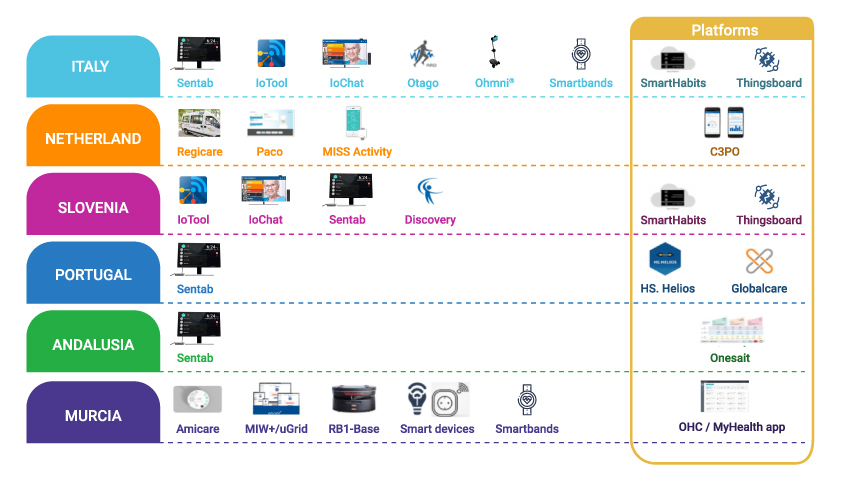
03 Dec PHArA-ON: Technologies that meet the demands for active and assisted ageing
The overall objective of the PHArA-ON project is to provide support for Europe’s ageing population by integrating digital services, devices, and tools into open platforms. These platforms will help to maintain the dignity of older adults while simultaneously enhancing their independence, safety, and capabilities. The project uses a range of digital tools including connected devices (e.g. the Internet of Things, IoT), artificial intelligence (AI), robotics, cloud and edge computing, smart wearables, big data, and intelligent analytics that will be integrated to provide personalised and optimised health care delivery.
One of the first steps was the mapping of new technologies available within the PHArA-ON consortium. Here, the main objective was to identify and contact relevant stakeholders, implement a monitoring repository, provide data extraction templates as well as gather and present the data in a user-friendly and approachable form in order to facilitate the connection between technology providers and the regional pilots. As a next step, the mapped technologies will be integrated into the CATAALOG platform, an internet platform giving an overview for active and assisted aging solutions, which is part of the overall PHArA-ON exploitation strategy. The CATAALOG platform requires a set of features in order to deploy the solutions on it. To this end, this set of features is being developed. It contains digital advisors, situation-based content, databases for suppliers, products, services, categories, brochures and use case descriptions aligned with the previously identified PHArA-ON challenges.
The Technologies
The data collection for the technologies considered four top level aspects:
- The functional capabilities of the technology to classify the type of technology and understand the main supported use cases from a generic perspective.
- The actual or planned commercialisation of the technology, depending on the maturity of the technology.
- Technical aspects to provide details on system integration capabilities and supported interoperability standards.
- The relation to PHArA-ON challenges (PHCs) and pilots, which, depending on the progress of the pilot planning, either reflects the actual plan or explains how the technology can be deployed in the context.
For each technology provider, structured profiles were created to make it easier to compare and match the technologies. All PHArA-ON technologies are already available on the market or will be implemented shortly (TRL 8-9). As shown in the figure below, the identified technologies can be divided in two categories, platforms and products. While platform solutions are available for all piloting regions, other challenges are still unaddressed on some pilot sites. To fill these gaps, open calls will be launched.

The technologies have been grouped in
- Collaboration and process layer – This category includes deployment and development tools as well as a digital marketplace containing the CATAALOG.
- Application layer – The offered applications particularly aim at improving care and wellbeing, health monitoring, managing health and cognitive stimulation, learning, socialisation and safe and comfortable environment.
- Service layer – The service layer primarily includes technical services such as Service broker and orchestrator, alerts and notifications, data analytics or visualisation.
- Platform layer – This layer determines the proposed applications’ performance on a data processing level, rules engines, communication platform and data storage.
- Device network layer – The device network layer includes device gateway, A/V communication devices, sensors, actuators and mobile robots.
- Management – These are technologies focussing on content, platform or device management.
- Interoperability – Another group contains technologies dealing with semantic interoperability, or building platform bridges.
- Security and Privacy – Identity and access management, service provision security, consent management, data security, communication security build the final group of technologies.
Examples of the technologies that are being used within PHArA-ON are apps and solutions such as a first aid translation helper, an eHealth platform, Indoor non-intrusive tracking of daily habits with configurable triggering alarms that can be installed on the carers’ smartphones, a health information system, Co-Robotics wearable devices or products empowering older adults living at home or in assisted living to connect with social media an well as health and care services through their TV set. As the mapping of according technologies continues, the pool of solutions increases. These technologies will also be included in the CATAALOG set up by MINDS & SPARKS.
